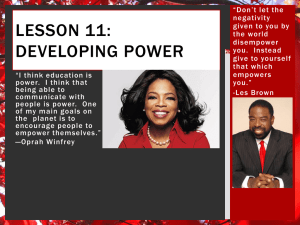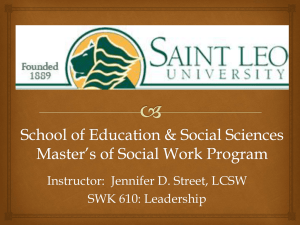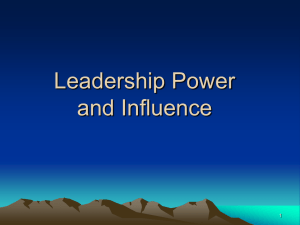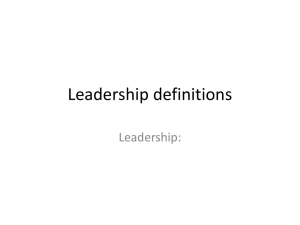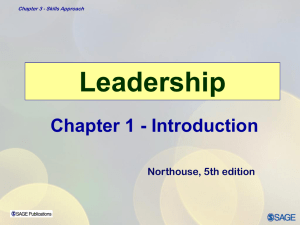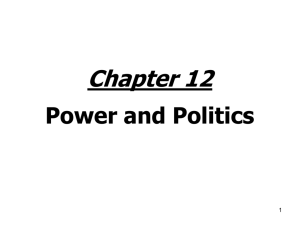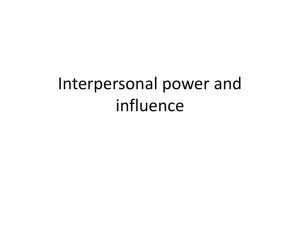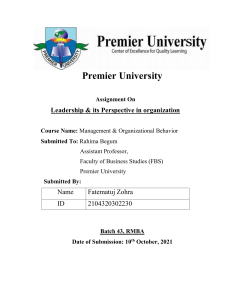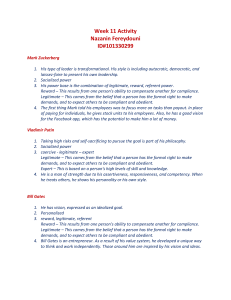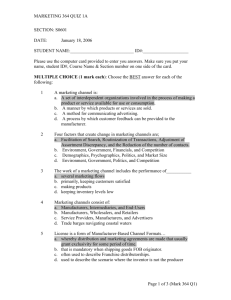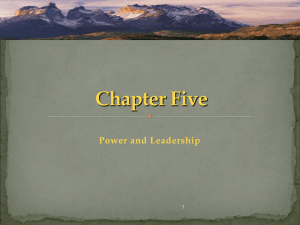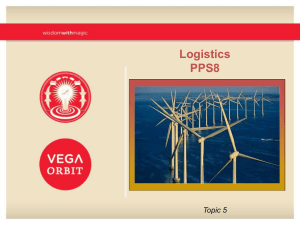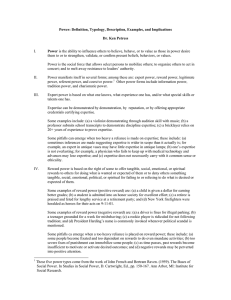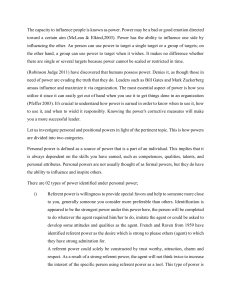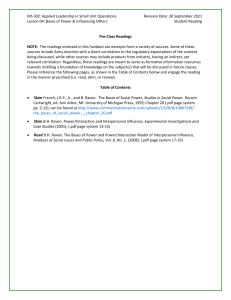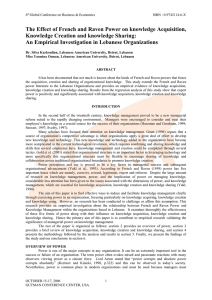Leadership across the organization Chapter 10 Although we are not
advertisement
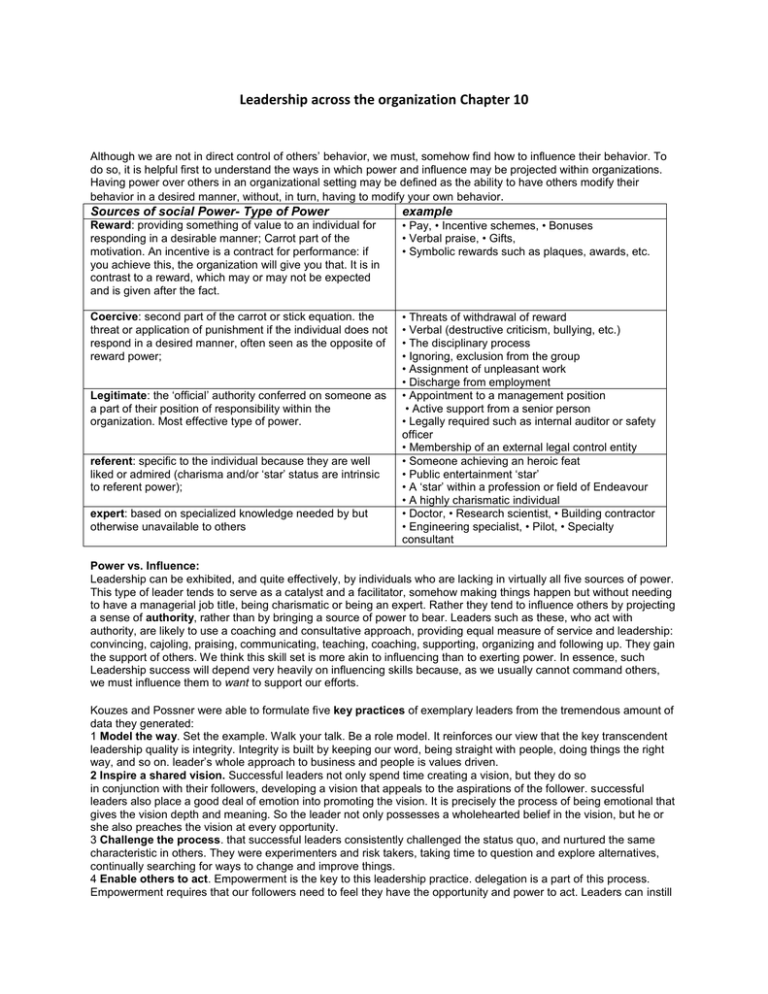
Leadership across the organization Chapter 10 Although we are not in direct control of others’ behavior, we must, somehow find how to influence their behavior. To do so, it is helpful first to understand the ways in which power and influence may be projected within organizations. Having power over others in an organizational setting may be defined as the ability to have others modify their behavior in a desired manner, without, in turn, having to modify your own behavior. Sources of social Power- Type of Power example Reward: providing something of value to an individual for responding in a desirable manner; Carrot part of the motivation. An incentive is a contract for performance: if you achieve this, the organization will give you that. It is in contrast to a reward, which may or may not be expected and is given after the fact. • Pay, • Incentive schemes, • Bonuses • Verbal praise, • Gifts, • Symbolic rewards such as plaques, awards, etc. Coercive: second part of the carrot or stick equation. the threat or application of punishment if the individual does not respond in a desired manner, often seen as the opposite of reward power; • Threats of withdrawal of reward • Verbal (destructive criticism, bullying, etc.) • The disciplinary process • Ignoring, exclusion from the group • Assignment of unpleasant work • Discharge from employment • Appointment to a management position • Active support from a senior person • Legally required such as internal auditor or safety officer • Membership of an external legal control entity • Someone achieving an heroic feat • Public entertainment ‘star’ • A ‘star’ within a profession or field of Endeavour • A highly charismatic individual • Doctor, • Research scientist, • Building contractor • Engineering specialist, • Pilot, • Specialty consultant Legitimate: the ‘official’ authority conferred on someone as a part of their position of responsibility within the organization. Most effective type of power. referent: specific to the individual because they are well liked or admired (charisma and/or ‘star’ status are intrinsic to referent power); expert: based on specialized knowledge needed by but otherwise unavailable to others Power vs. Influence: Leadership can be exhibited, and quite effectively, by individuals who are lacking in virtually all five sources of power. This type of leader tends to serve as a catalyst and a facilitator, somehow making things happen but without needing to have a managerial job title, being charismatic or being an expert. Rather they tend to influence others by projecting a sense of authority, rather than by bringing a source of power to bear. Leaders such as these, who act with authority, are likely to use a coaching and consultative approach, providing equal measure of service and leadership: convincing, cajoling, praising, communicating, teaching, coaching, supporting, organizing and following up. They gain the support of others. We think this skill set is more akin to influencing than to exerting power. In essence, such Leadership success will depend very heavily on influencing skills because, as we usually cannot command others, we must influence them to want to support our efforts. Kouzes and Possner were able to formulate five key practices of exemplary leaders from the tremendous amount of data they generated: 1 Model the way. Set the example. Walk your talk. Be a role model. It reinforces our view that the key transcendent leadership quality is integrity. Integrity is built by keeping our word, being straight with people, doing things the right way, and so on. leader’s whole approach to business and people is values driven. 2 Inspire a shared vision. Successful leaders not only spend time creating a vision, but they do so in conjunction with their followers, developing a vision that appeals to the aspirations of the follower. successful leaders also place a good deal of emotion into promoting the vision. It is precisely the process of being emotional that gives the vision depth and meaning. So the leader not only possesses a wholehearted belief in the vision, but he or she also preaches the vision at every opportunity. 3 Challenge the process. that successful leaders consistently challenged the status quo, and nurtured the same characteristic in others. They were experimenters and risk takers, taking time to question and explore alternatives, continually searching for ways to change and improve things. 4 Enable others to act. Empowerment is the key to this leadership practice. delegation is a part of this process. Empowerment requires that our followers need to feel they have the opportunity and power to act. Leaders can instill a sense of power and control by allowing followers to make decisions. Indecisiveness is not tolerated while decisiveness is rewarded. The best performing teams are those in which the leadership function is shared. 5 Encourage the heart. Perhaps the most underutilized resource in today’s organizations is the pride And enthusiasm of their employees. Conversely, goals and standards are clearly set at a high but achievable standard. And when those goals are met and exceeded, they are recognized and celebrated, personally and publicly. Followers of course want to achieve and feel that their talents are being well used, but they also want to know that their efforts are appreciated by their employing organization. Leadership practice Challenge the process Inspire a shared vision Enable others to act Model the way; Encourage the heart Supporting behavior • Seeking opportunities that challenge and test our skills and abilities • Keeping up to date on the most recent developments in the organization • Keeping up to date on the most recent developments in our field • Challenging the methods, processes and procedures we use at work • Looking for innovative ways to improve what we do • Asking ‘what can we learn?’ when things do not work out as expected • Experimenting with new approaches even if we might fail • Discussing the kind of future we could create together • Appealing to one another to ‘buy in’ to one another’s dream of the future • Communicating positive and hopeful outlooks for the organization • Showing one another how their individual future interests can be served by enlisting in a common vision • Looking ahead and forecasting the future • Sharing excitement and enthusiasm about future possibilities • Involving others in planning • Treating one another with respect and dignity • Giving people the discretion to make their own decisions and the training to make them correctly • Developing cooperative relationships with one another • Creating an atmosphere of mutual trust • Generating a sense of ownership among all of us over the work we do • Being clear about our philosophies of leadership, management and work • Breaking projects down into manageable chunks • Ensuring people adhere to the values and ideals to which we have agreed • Discussing our beliefs about how to run the organization • Consistently practicing the values, ideals and philosophies we espouse • Setting clear goals, plans and milestones for our work • Celebrating our accomplishments when we reach milestones or achieve goals • Recognizing people for their contributions to our success • Praising one another for a job well done • Giving one another appreciation and support for their contributions • Finding ways to celebrate our successes • Telling the rest of the organization about the good work we do Learning Summary Leaders often need to provide leadership across their organization, influencing individuals and teams from other areas, areas over which they have no formal authority. Organizational leadership is substantially different from individual and team leadership in that it may be required to consider organizational purpose, politics and history within the context of the wider community while involving any simultaneous situations within a longer timeframe. A model of social power includes five sources of such power: reward power, coercive power, legitimate power, referent power and expert power. Reward, legitimate and expert power may be viewed as positive and desirable methods to support leadership aims. Coercive power is not likely to be as effective, because of its unpredictable outcomes, while few individuals will find referent power to be a long-term source of support within an organization. Influencing skills are an additional source of leadership success in that they can be employed with little social power but also in conjunction with social power. Kouzes and Posner identified five leadership practices of successful leaders that any leader may successfully employ: model the way, inspire a shared vision, challenge the process, enable others to act, and encourage the heart. Organizational leadership and its associated influencing skills will be of increasing importance to leaders in the 21st century.
